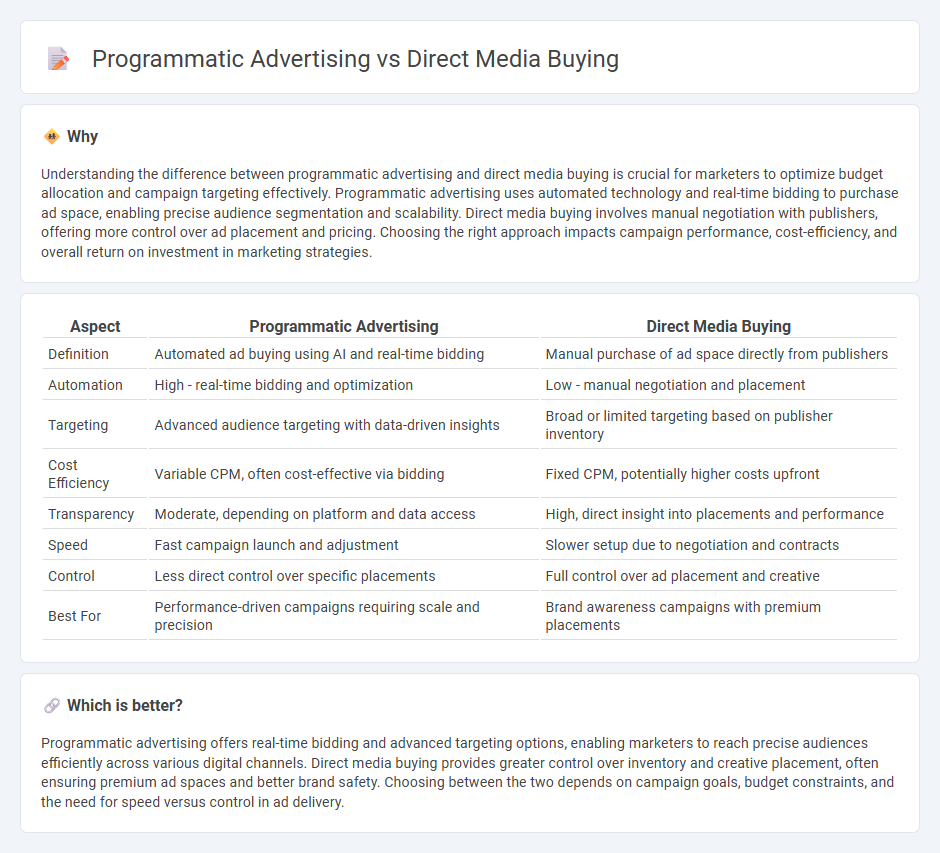
Programmatic advertising leverages automated technology and real-time bidding to optimize ad placements across diverse digital platforms, enhancing targeting precision and campaign efficiency. Direct media buying involves negotiating and purchasing ad space directly from publishers, offering greater control over inventory and placement but often at higher costs and less flexibility. Explore these methods further to determine the best approach for your marketing strategy.
Why it is important
Understanding the difference between programmatic advertising and direct media buying is crucial for marketers to optimize budget allocation and campaign targeting effectively. Programmatic advertising uses automated technology and real-time bidding to purchase ad space, enabling precise audience segmentation and scalability. Direct media buying involves manual negotiation with publishers, offering more control over ad placement and pricing. Choosing the right approach impacts campaign performance, cost-efficiency, and overall return on investment in marketing strategies.
Comparison Table
| Aspect | Programmatic Advertising | Direct Media Buying |
|---|---|---|
| Definition | Automated ad buying using AI and real-time bidding | Manual purchase of ad space directly from publishers |
| Automation | High - real-time bidding and optimization | Low - manual negotiation and placement |
| Targeting | Advanced audience targeting with data-driven insights | Broad or limited targeting based on publisher inventory |
| Cost Efficiency | Variable CPM, often cost-effective via bidding | Fixed CPM, potentially higher costs upfront |
| Transparency | Moderate, depending on platform and data access | High, direct insight into placements and performance |
| Speed | Fast campaign launch and adjustment | Slower setup due to negotiation and contracts |
| Control | Less direct control over specific placements | Full control over ad placement and creative |
| Best For | Performance-driven campaigns requiring scale and precision | Brand awareness campaigns with premium placements |
Which is better?
Programmatic advertising offers real-time bidding and advanced targeting options, enabling marketers to reach precise audiences efficiently across various digital channels. Direct media buying provides greater control over inventory and creative placement, often ensuring premium ad spaces and better brand safety. Choosing between the two depends on campaign goals, budget constraints, and the need for speed versus control in ad delivery.
Connection
Programmatic advertising and direct media buying are connected through their shared goal of efficient ad placement, with programmatic leveraging automated technology to purchase media in real-time auctions while direct buying involves negotiated deals with publishers. Both methods aim to optimize targeting and budget allocation, enhancing campaign performance by combining data-driven automation and direct relationships. Integrating programmatic tools into direct buying strategies can increase transparency, control, and ROI in digital marketing campaigns.
Key Terms
Manual Negotiation
Direct media buying involves manual negotiation between advertisers and publishers to secure ad placements, allowing for tailored deals and personalized campaign strategies. This hands-on approach offers greater control over inventory, pricing transparency, and premium placements, unlike programmatic advertising, which relies on automated real-time bidding algorithms. Explore the benefits and challenges of manual negotiation in media buying to optimize your advertising impact.
Real-Time Bidding (RTB)
Direct media buying involves purchasing ad space directly from publishers, ensuring fixed placements and predictable costs, while programmatic advertising utilizes automated systems like Real-Time Bidding (RTB) to buy impressions instantaneously across multiple platforms. RTB enables advertisers to bid dynamically on individual ad impressions in real-time auctions, optimizing for target audience and budget efficiency with data-driven precision. Explore the nuances of RTB to enhance your digital advertising strategy and maximize ROI.
Ad Inventory
Direct media buying offers advertisers guaranteed access to premium ad inventory through negotiated placements on specific websites or platforms, ensuring control over where ads appear. Programmatic advertising utilizes automated technology to purchase ad space in real time across multiple inventories, enabling precise audience targeting and efficient budget allocation. Discover the advantages and trade-offs of each approach to optimize your ad inventory strategy.
Source and External Links
Direct vs Programmatic Advertising: Which Strategy Works Best? - Direct media buying is a traditional method where advertisers purchase ad space directly from publishers or media owners, involving negotiation of pricing, placements, and campaign duration, offering greater control and transparency compared to programmatic methods.
Programmatic Advertising vs Direct Buying - Direct buying allows advertisers to choose exact ad placements, guarantees impressions, ensures brand safety, and provides predictable fixed costs, making it ideal for premium placements and exclusive partnerships.
What Is Direct Response Media Buying (DRTV)? - Direct response media buying focuses on purchasing ad inventory with measurable consumer responses, using unique call-to-action mechanisms to track and optimize on sales or leads rather than traditional viewer ratings.
 dowidth.com
dowidth.com